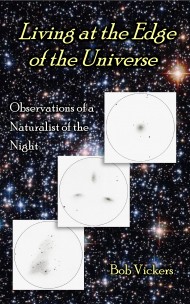Here are a couple of Galaxy Trios and a couple of Hicksons observed over the past month or so. The first is Galaxy Trio 21 or the NGC 3128 Trio in Hydra. These three very elongated galaxies form a nearly equilateral triangle. They each have a fairly even brightness around magnitude 14.
On the opposite end of the shape spectrum is Trio 22 or the NGC 3202 trio. It is a compact group of three roundish galaxies in Ursa Major, all around magnitude 13.2. NGC 3207 actually appears to me to be the brightest of the three and is visible with direct vision. It has a bright, almost stellar, nucleus surrounded by a small roundish halo.
On the same evening that I observed the galaxy trio above, I also found the two bright asteriods Vesta and Ceres. They were about two degrees apart in the constellation Virgo, Vesta near 84 Virginis and Ceres near 78 Virginis. The view through my finder scope (sketched below) reminded me of the “double-double” star Epsilon Lyrae. They will appear closest in the sky on July 5th at only 10 arcminutes apart.
The Hickson 42 compact galaxy group consists of one larger and brighter galaxy (NGC 3091) surrounded by three smaller and dimmer ones. I managed to snag all of these galaxies, even P28926 which, at magnitude 15.8, was an extremely dim round spot on the very edge of visibility.
Finally, was the Hickson compact galaxy group 61, also known as “The Box.” This group is an interesting rectangular or box-shaped arrangement of four fairly bright, mostly elongated galaxies. Two of them, NGC 4169 and NGC 4174 were visible with direct vision while the dimmest, NGC 4173, was visible only as an elusive dim haze. N4173 is actually a foreground galaxy about 60 million light years distant. The other three galaxies are about 180 million light years away. (See the Sky & Telescope article: The Gossamers of Coma Berenices by Sue French in the May 2010 issue, page 67.)

- Copyright (c) 2014 Robert D. Vickers, Jr." width="500" height="294" srcset="https://www.thenightskynaturalist.com/wp-content/uploads/2014/05/Hickson-61-1024x603.jpg 1024w, https://www.thenightskynaturalist.com/wp-content/uploads/2014/05/Hickson-61-300x176.jpg 300w, https://www.thenightskynaturalist.com/wp-content/uploads/2014/05/Hickson-61.jpg 1937w" sizes="(max-width: 500px) 100vw, 500px" />
Hickson Galaxy Group 61 (AKA “The Box” – Copyright (c) 2014 Robert D. Vickers, Jr.
– Copyright (c) 2014 Robert D. Vickers, Jr.
